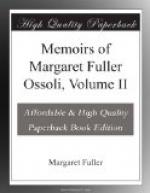failing. Margaret requested to be left alone
with her; and to her question, ’Are you ‘willing
to die?’ the woman answered, “Yes;”
adding, with her usual bitterness, “not on religious
grounds, though.” ’That is well,—to
understand yourself,’ was Margaret’s rejoinder.
She then began to talk with her about her health,
and her few comforts, until the conversation deepened
in interest. At length, as Margaret rose to go,
she said: ’Is there not anything I can do
‘for you?’ The woman replied: “I
should be glad if you will pray with me.”
The condition of these wretched beings was brought the more home to her heart, as the buildings were directly in sight from Mr. Greeley’s house, at Turtle Bay, where Margaret, on her arrival, went to reside. ‘Seven hundred females,’ she writes,
’are now confined in the Penitentiary opposite this point. We can pass over in a boat in a few minutes. I mean to visit, talk, and read with them. I have always felt great interest in those women who are trampled in the mud to gratify the brute appetites of men, and wished that I might be brought naturally into contact with them. Now I am.’
THE TRIBUNE AND HORACE GREELEY.
It was early in December of 1844 that Margaret took up her abode with Mr. and Mrs. Greeley, in a spacious old wooden mansion, somewhat ruinous, but delightfully situated on the East River, which she thus describes:—
’This place is, to me, entirely charming; it is so completely in the country, and all around is so bold and free. It is two miles or more from the thickly settled parts of New York, but omnibuses and cars give me constant access to the city, and, while I can readily see what and whom I will, I can command time and retirement. Stopping on the Haarlem road, you enter a lane nearly a quarter of a mile long, and going by a small brook and pond that locks in the place, and ascending a slightly rising ground, get sight of the house, which, old-fashioned and of mellow tint, fronts on a flower-garden filled with shrubs, large vines, and trim box borders. On both sides of the house are beautiful trees, standing fair, full-grown, and clear. Passing through a wide hall, you come out upon a piazza, stretching the whole length of the house, where one can walk in all weathers; and thence by a step or two, on a lawn, with picturesque masses of rocks, shrubs and trees, overlooking the East River. Gravel paths lead, by several turns, down the steep bank to the water’s edge, where round the rocky point a small bay curves, in which boats are lying. And, owing to the currents, and the set of the tide, the sails glide sidelong, seeming to greet the house as they sweep by. The beauty here, seen by moonlight, is truly transporting. I enjoy it greatly, and the genius loci receives me as to a home.’
Here Margaret remained for a year and more, writing regularly for the Tribune. And how high an estimate this prolonged and near acquaintance led her to form for its Editor, will appear from a few passages in her letters:—




